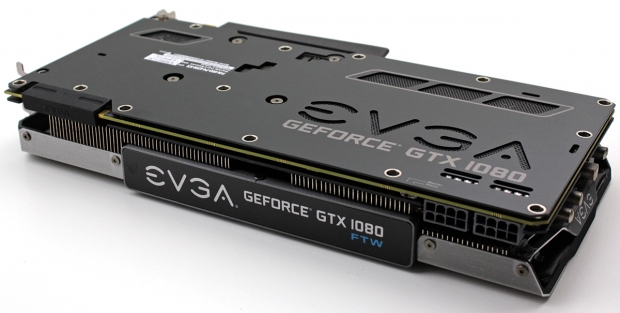Index
Review: Has the new ACX 3.0 cooler and a light show
We like the way EVGA has designed its new GTX 1080 FTW graphics card. It looks as powerful as it is and will drive you the fastest route through any journey.
The Geforce GTX 1080 is consumer graphics cards which belongs to the new Geforce Pascal generation. It is the right card to experience a new class of performance enhanced and VR gaming. The user can freely experiment with all the new Nvidia features, and we believe it has enough future-proof gear under the hood to drive whatever comes next.
Nvidia has introduced its reference GTX 1080 “Founders Edition” and its partners are good to go with custom designs. EVGA as one of the oldest and most experienced partners knows how to gain attention of the users. This time EVGA has two custom coolers. The first one is based on the reference blower cooler and the second comes from the new Active Cooling Xtreme 3.0 (ACX) 3.0 cooler generation. EVGA is yet to release a Classified, Kingpin, or Hydro Copper version of the GTX 1080, and we expect to see another version of ACX 3.0 cooler and one with a water cooling solution.
EVGA GTX 1080 FTW which we review today uses the ACX 3.0 cooler. This cooler has so many small cool visually appealing details that the best way to present all of them to our readers is through a series of images. Here we show just one image of the GTX 1080 FTW card and we left more detailed images and descriptions for the later sections. Please notice that the ACX 3.0 cooler is a higher than a standard graphics card cooler, but EVGA decided to keep it two slots wide, and you will appreciate this if you decide to go for SLI.
Before we go into detail about FTW card, it is important to compare the GTX 1080 (using GP104 GPU) to its predecessor the GTX 980 (using GM204 GPU), but we will give some details for the GTX 1070, the weaker brother of the GTX 1080. The GTX 1080 and the GTX 1070 are based on the same GP104 GPU, however the GTX 1070 has a lower performance due to some shortcuts through the GPU.
The new Pascal architecture uses TSMC's 16nm FinFET node which is more advanced compared to the 28nm used for the GM204, and for the GM200 (GTX 980 Ti). By lowering the physical size of transistors it was possible to squeeze 7.2 billion transistors into a 314 mm² package. Compare this to the 5.2 billion transistors packed into 398 mm² for the GM204. This means the GP104 has 22.9 million transistors per mm2, compared to only 13.1 million transistors per mm2 for the GM204.
There are optimisations and improvements across the GPU that provide a better performance per watt. As in the previous generation, the GPU core is divided into four graphics processing clusters (GPC), but the GP104 GPU has less shared resources and more dedicated resources which leads to better performance.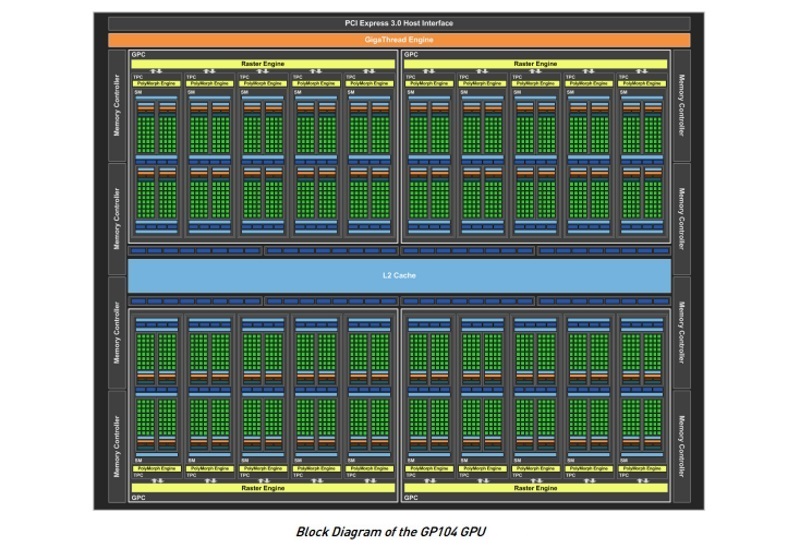
The GTX 1080 has more CUDA cores (2560 vs. 2048) and more TMUs (160 vs. 128). The ALUs design is unchanged. There are still 128 CUDA cores per streaming multiprocessor (SSM) and data throughput per clock of this unit is the same compared to the Maxwell generation. Now there are five SMMs per GPC instead of the previous four SMMs per GPC.
Memory has been increased (8GB vs. 4GB), and bandwith (320GB/s vs. 224GB/s) too. Unlike AMD, Nvidia is not using the new HBM2 memory. It deploys fast GDDR5X memory. This provides 320GB/s bandwith, previously being available only by implementing 384-bit or 512-bit GDDR5 memory interfaces. The base GPU clock is set at 1607MHz, while the boost clock is 1733MHz. The GP104 likes overclocking and we went beyond 2GHz easily.
EVGA GTX 1080 FTW graphics card used in this review had a hefty factory overclock which sets the base GPU clock to 1721MHz, which is almost high as the boost clock of the reference card. The memory clock is not increased from reference 10000MHz, which is unfortunate, but until now you probably know that EVGA never overclocks memory.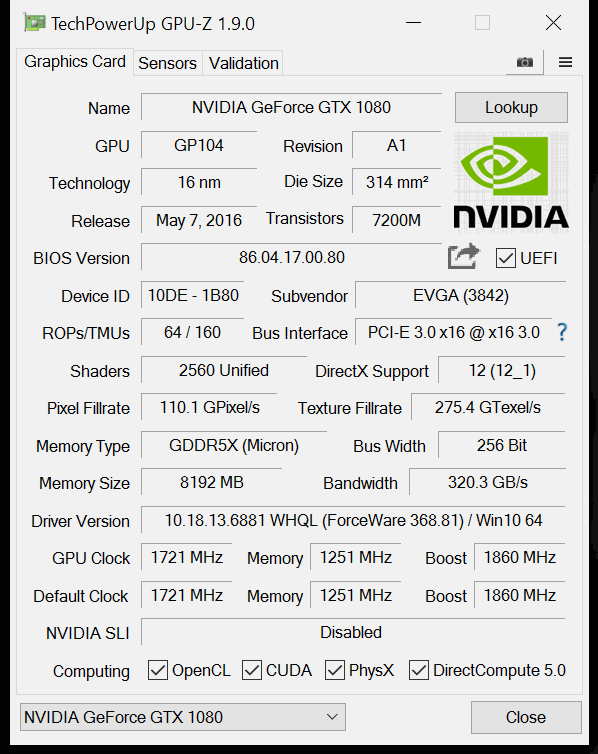
The Packaging
The front side of the box is simple, it shows the graphics card version, in this case it is For the win (FTW) model graphics cards come with a higher clock speed and are more likely to overclock further than a reference card. Each card is hand tested and guaranteed stable at the advertised clock speeds. SSC stands for super-super clocked and is one below FTW. This means the card is factory overclocked by EVGA and has been tested for stability for overclocked clocks. SC stands for super clocked. It is the lowest overclock EVGA offers but is still tested and guaranteed stable at the advertised speed.

The box is pretty nice. It is not too big, it's just the right size.
The ACX 3.0 cooler uses 10cm fans, and some description of the used fans is also provided on the box side.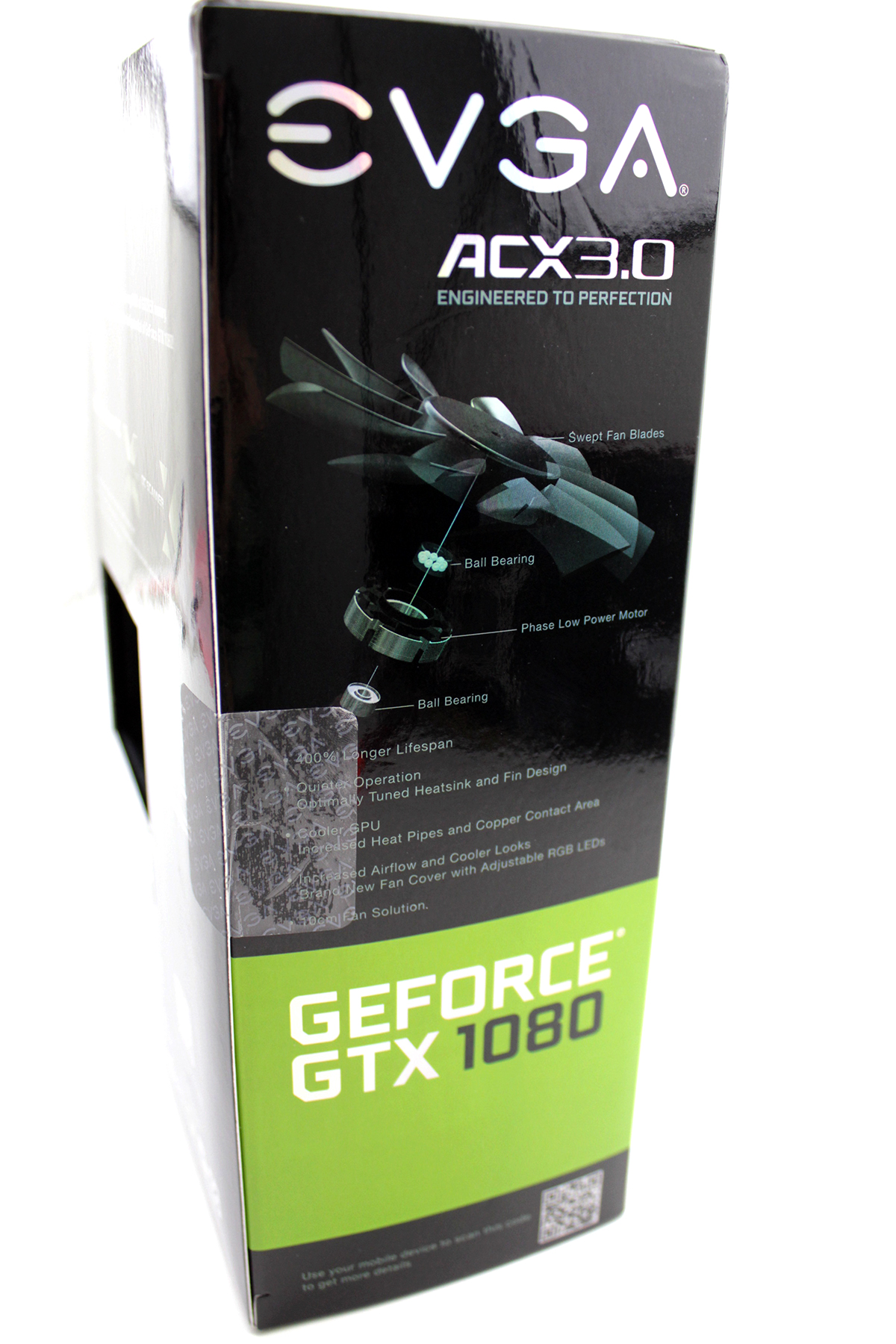
This packaging is sturdy and can survive nasty transport conditions.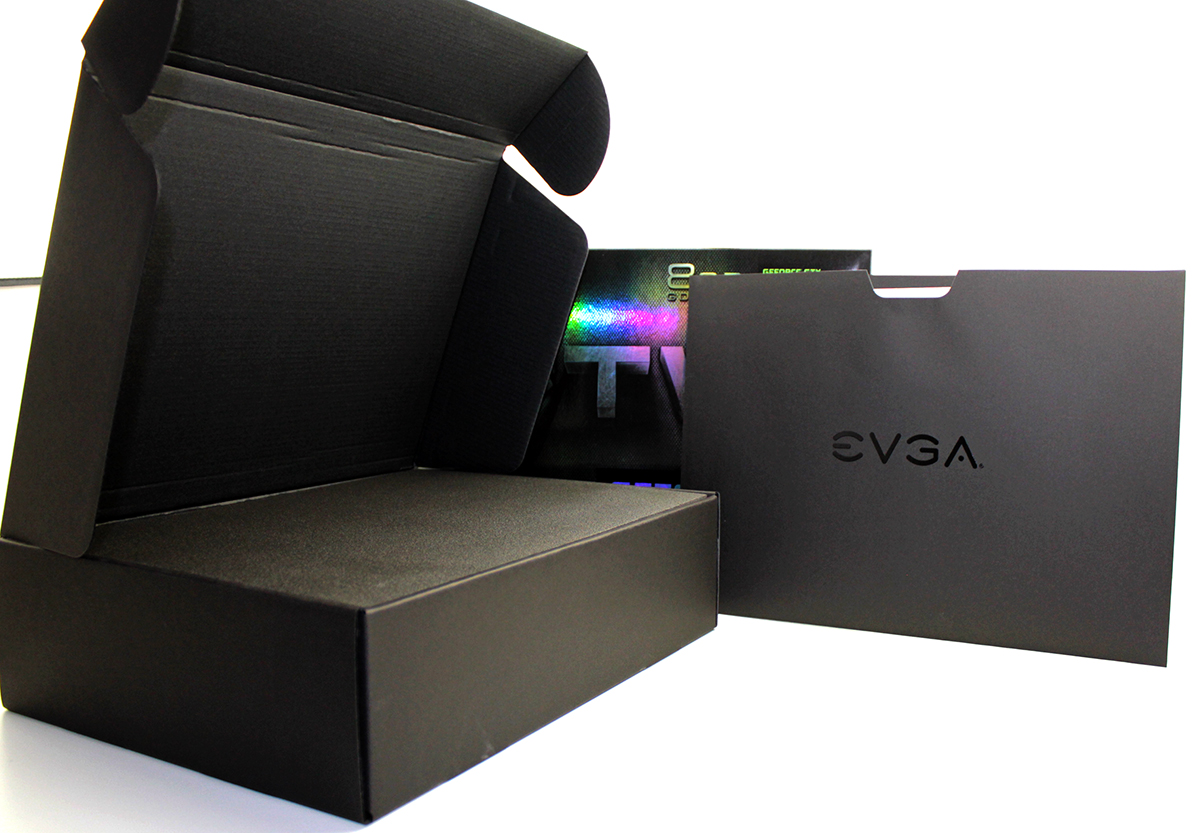
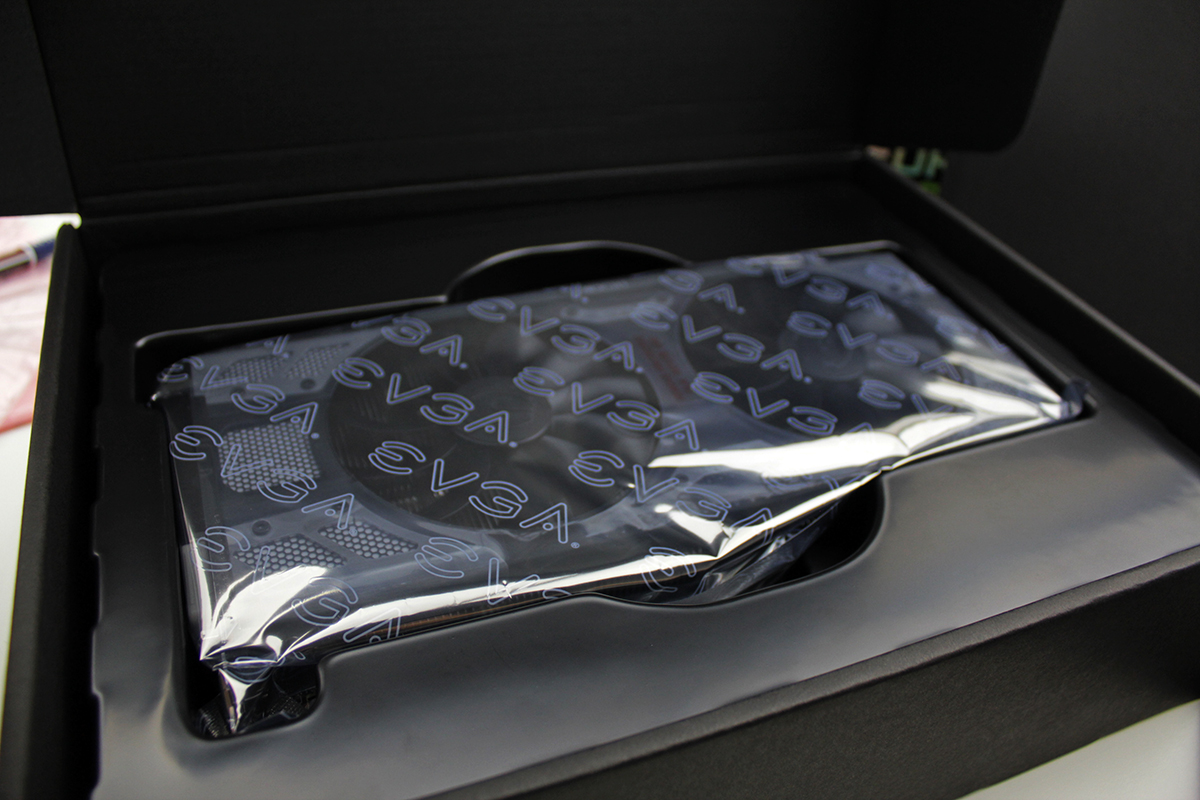
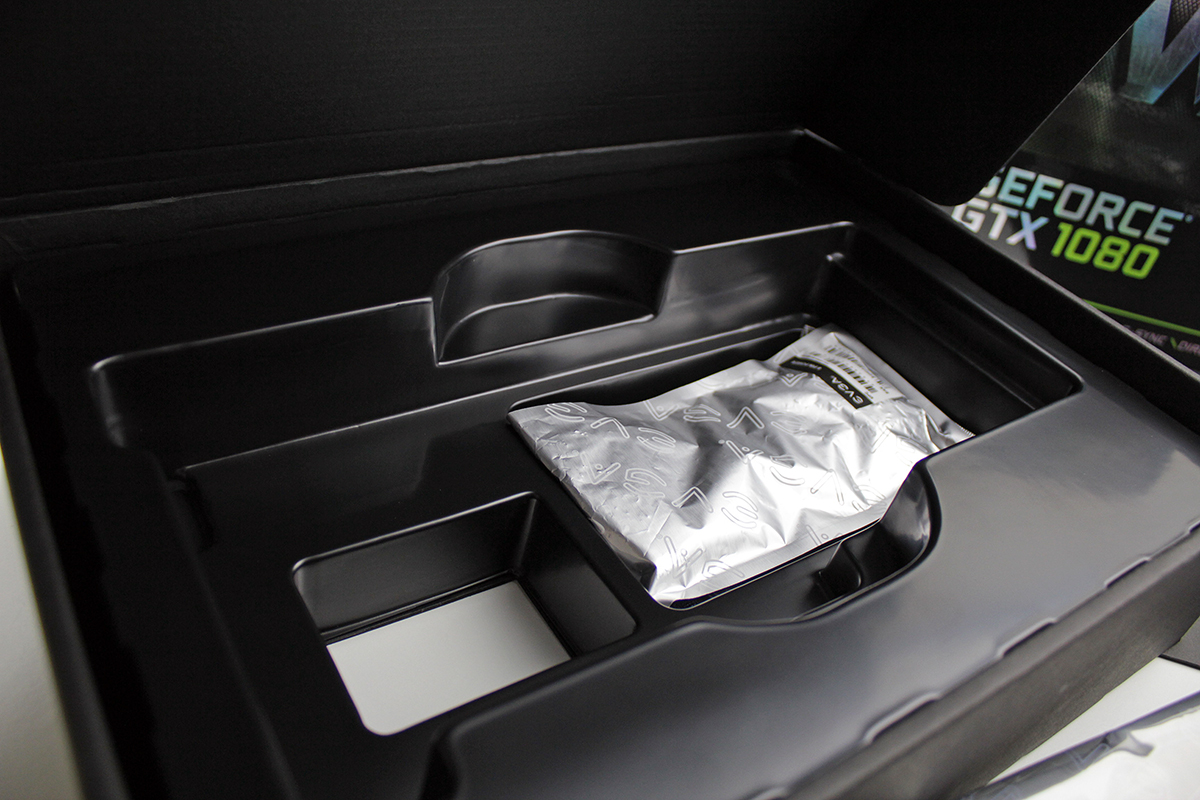
In the box you’ll find:
- EVGA Full Size Poster
- A User Guide and Quick Installation Guide
- A sticker set (Enthusiast Built)
- Driver DVD
- A small note about PCIE 3 compatibility
- EVGA Case Badge
- 2x 6-pin to 8-pin Power Adapter (the card uses non-reference 8-pin power connector)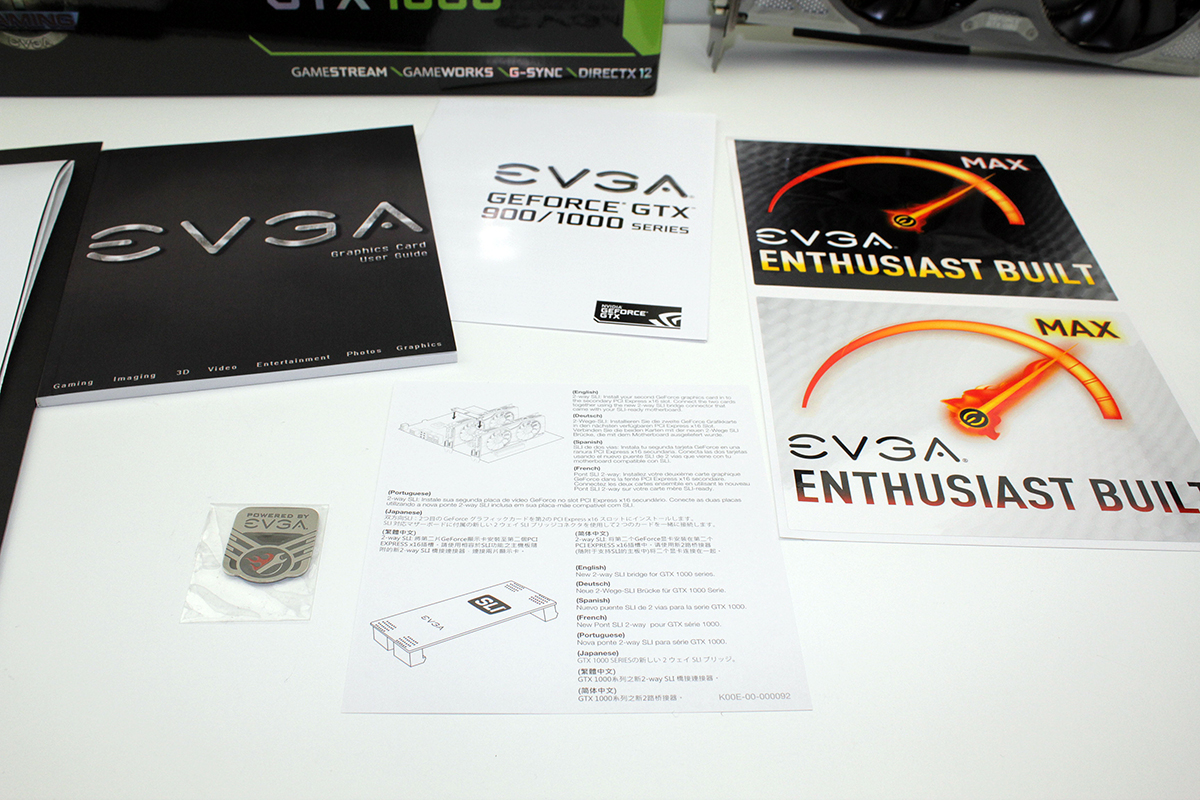

A closer look at GTX 1080 FTW
EVGA has created ACX 2.0 cooler for the Geforce 900 series. We were impressed with the cooling performance and the build quality. Now for the GTX 1000 series EVGA has crafted ACX 3.0 cooler, which is much bigger. It has its roots in the in the GTX 980 Ti Classified which was equiped with an oversized ACX 2.0 cooler. The next image shows the new GTX 1080 FTW graphics card followed by the GTX 980 Ti FTW and the GTX 980 Ti Classified.
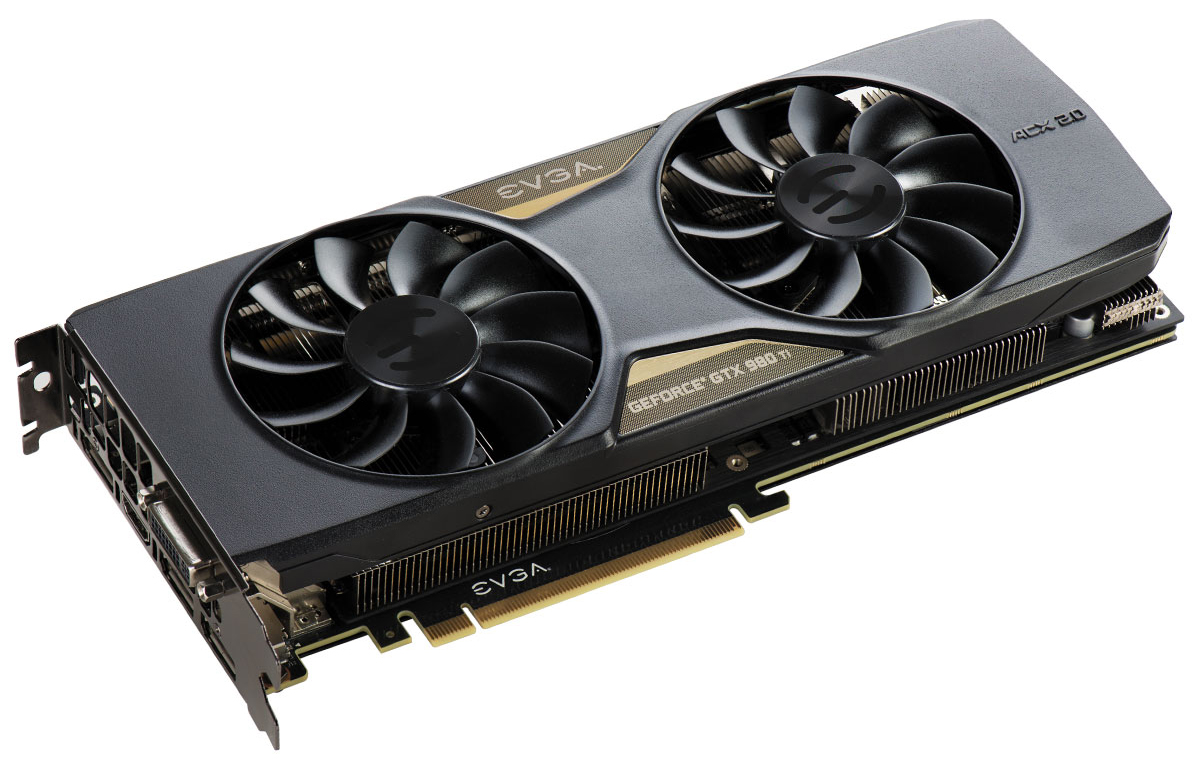
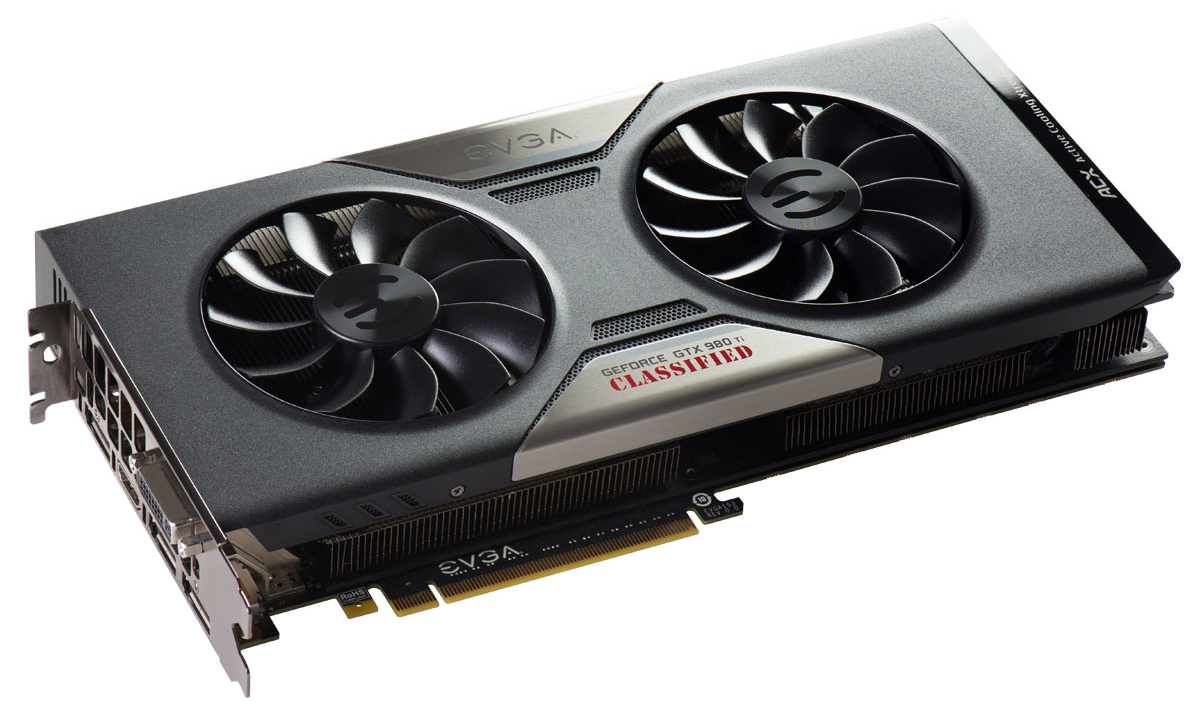
The new GTX 1080 FTW measures 26.67cm x 12.86cm, and this is the confirmation that we are looking at an oversized graphics card. But still, we’re talking about 2-slots width, with a card which is 2cm taller than standard. A quick look over what other Nvidia's AIB partners have done for the GTX 1080 shows that almost all of them have made oversized coolers in order to keep low GPU temperatures. Some AIB partners resort to a bulky triple-slot coolers to reduce noise and allow higher clocks, while keeping the GPU under the thermal threshold. GTX 1080 FTW at least keeps standard width. Next image shows Gainward GTX 1080 Phantom graphics card with a 3-slots wide cooler.
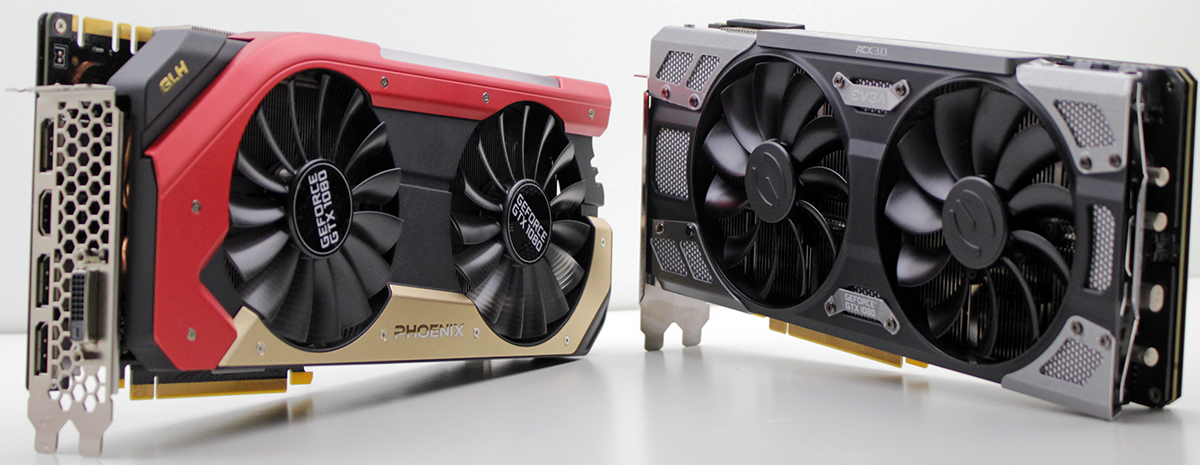
The ACX 3.0 cooler comes with a large heatsink and it relies on two 10cm fans for good cooling.
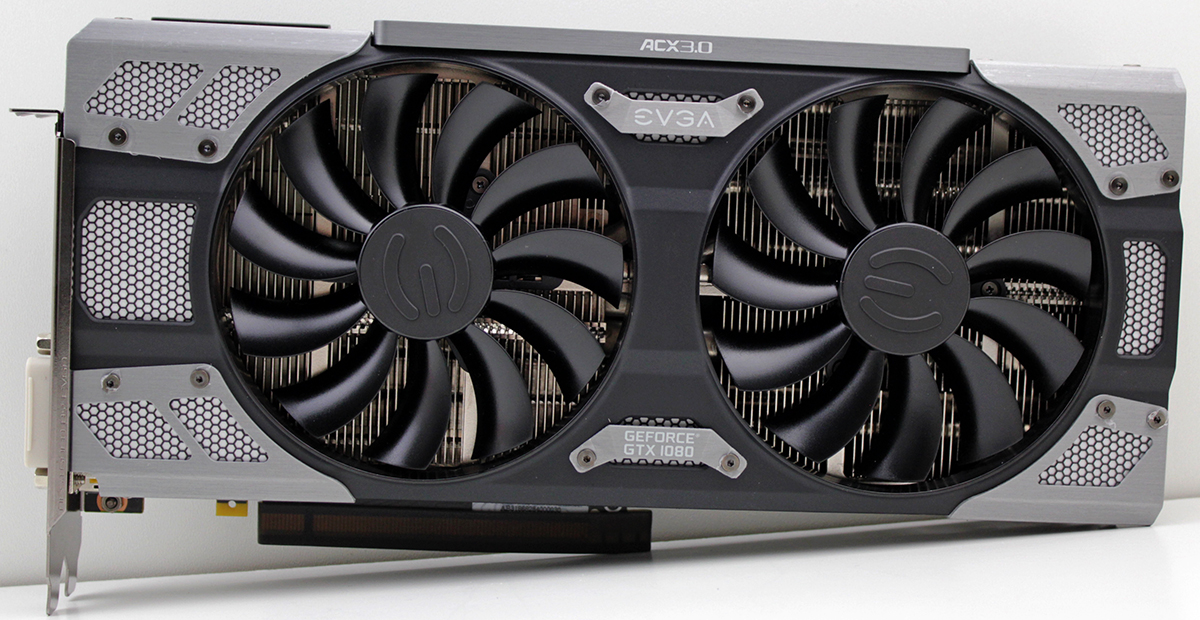
The ACX 3.0 cooler has most advanced illumination system that we have seen so far, and it looks great, as you can below. EVGA Precision XOC Utility provides interface to customize those light effects.
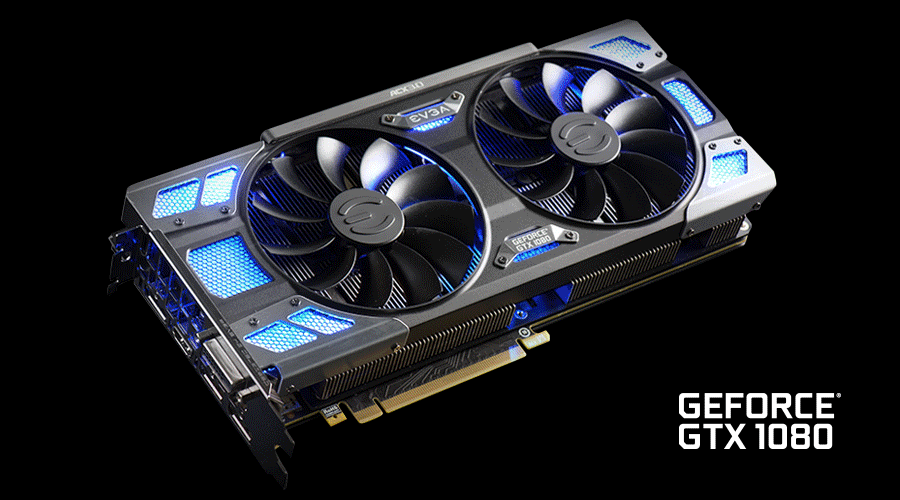
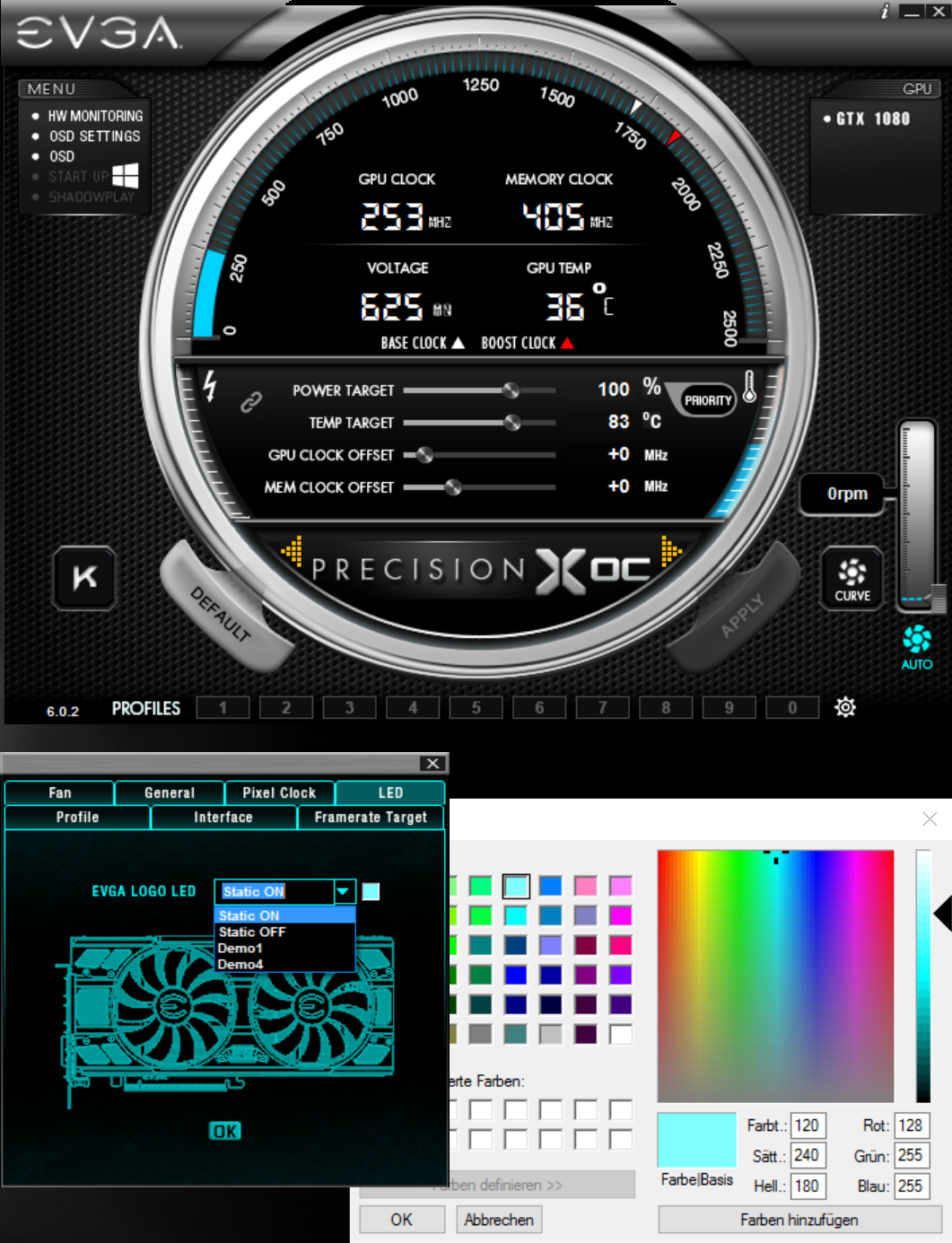
Before we continue, we want to show you how the card looks out of the box. As you can see it is fully covered 'protected' with plastics film.
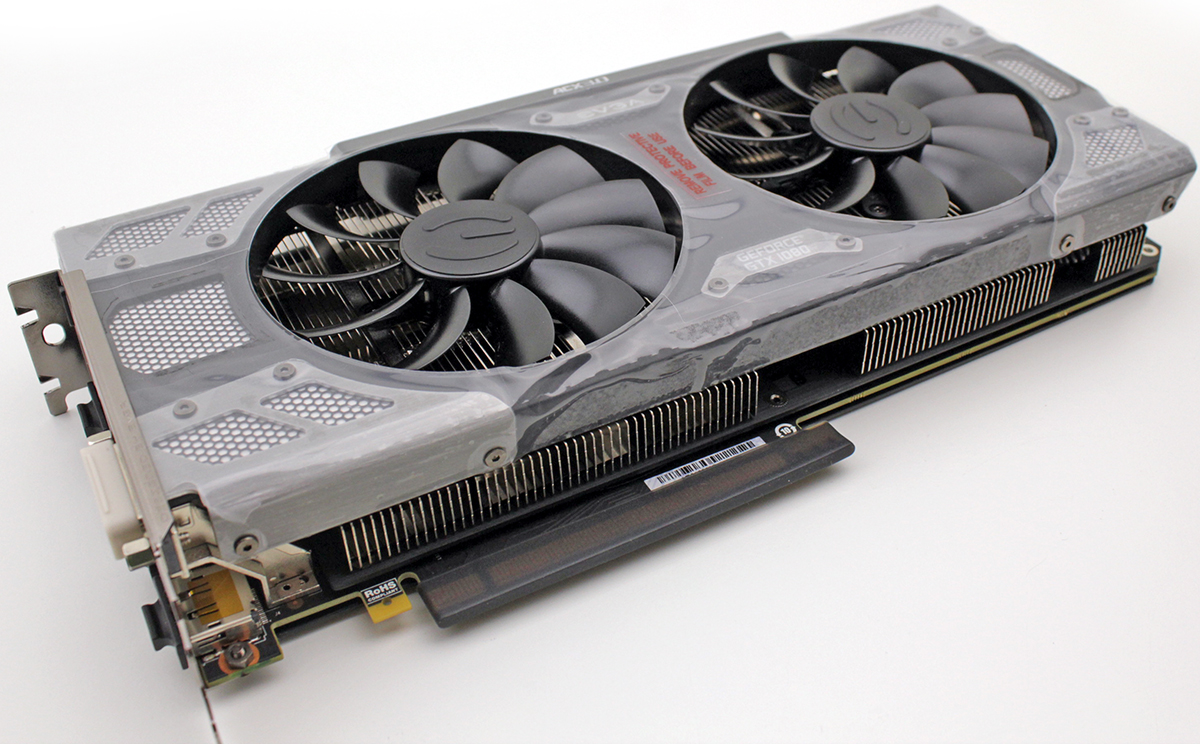
Oddly, there are two layers of film at some places, and someone screwed the screws through it so we were not able to remove the plastic film completely.
A closer look continued
The shroud of ACX 3.0 cooler is made of many small parts. 
And it is 'Desiged by EVGA'.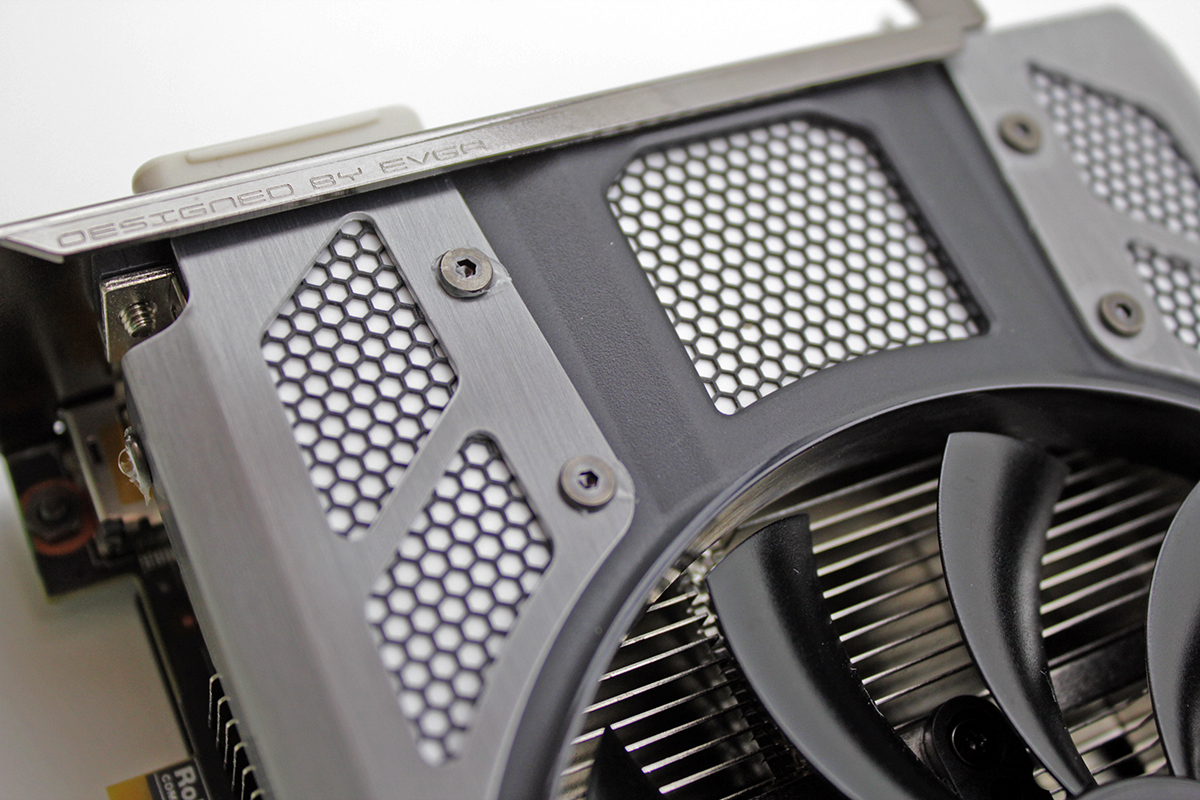
The shroud (black part of it) is made of quality nice looking plastic with brushed aluminium trimmings, otherwise it would be too heavy. It is open on all sides and the openings serve as exhaust vents.
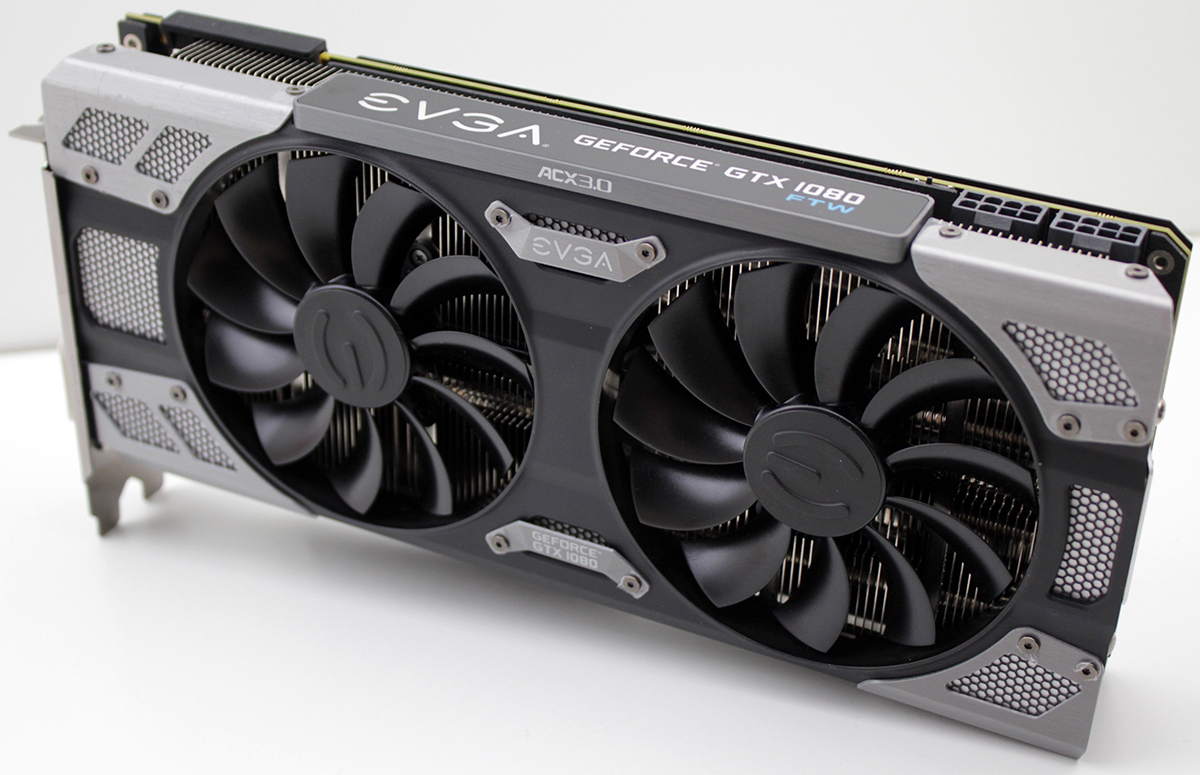
A backplate has become standard for the EVGA's high end graphics cards. It is not that important for the cooling but the backplate adds much to the overall image of the card, and this one looks particularly nice. A backplate is an important part of the ACX 3.0 cooler since it helps reinforce the PCB.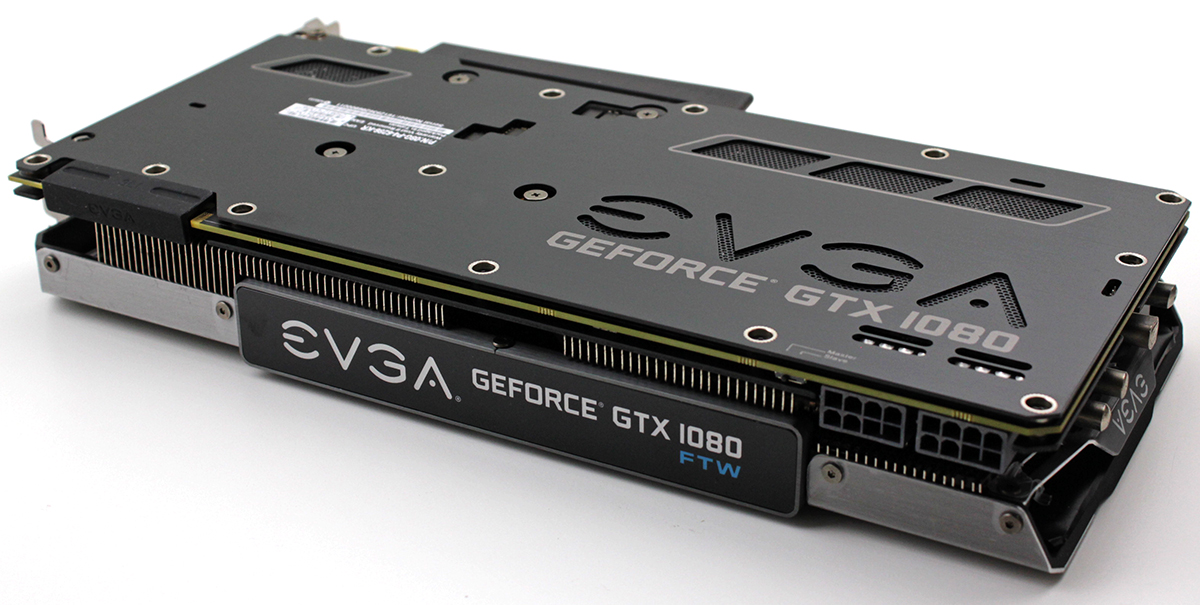
While the GTX 1080 Founders Edition draws 180 watts of power over a single 8-pin connection, the EVGA GTX 1080 FTW is rated at a 215W TDP via a pair of 8-pin connectors (each up to 150W). Maximum total graphics power for the GTX 1080 FTW is 258W. This means the card would be good with one 8-pin and one 6-pin power connector, but EVGA decided that dual 8-pin setup is better for feeding the 10 phase power and providing the core with clean filtered power. More phases means less heat per phase, and since we get more stable power delivery this should provide better overclocking. However, when ti comes to overclocking your GPU’s maximum speed always depends on how lucky you get in the GPU lottery.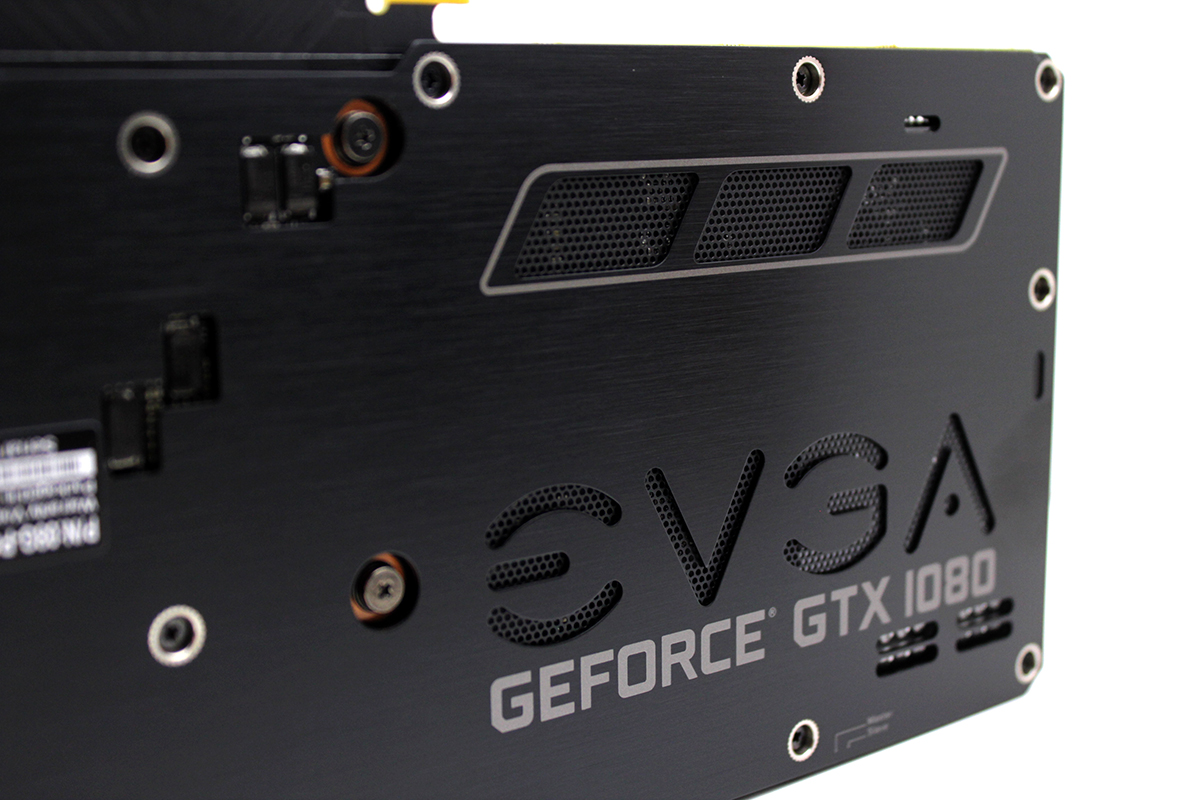
This card is meant for overclocking and QSD (Quick Switch Dual BIOS) allows you to switch to the secondary BIOS with the flick of a switch. The BIOS switch is located close to the PCI power connector. Be aware that changing the bios does void the warranty, but since the card has a pair of BIOS chips, you can safely modify/flash the slave(secondary) without voiding the warranty.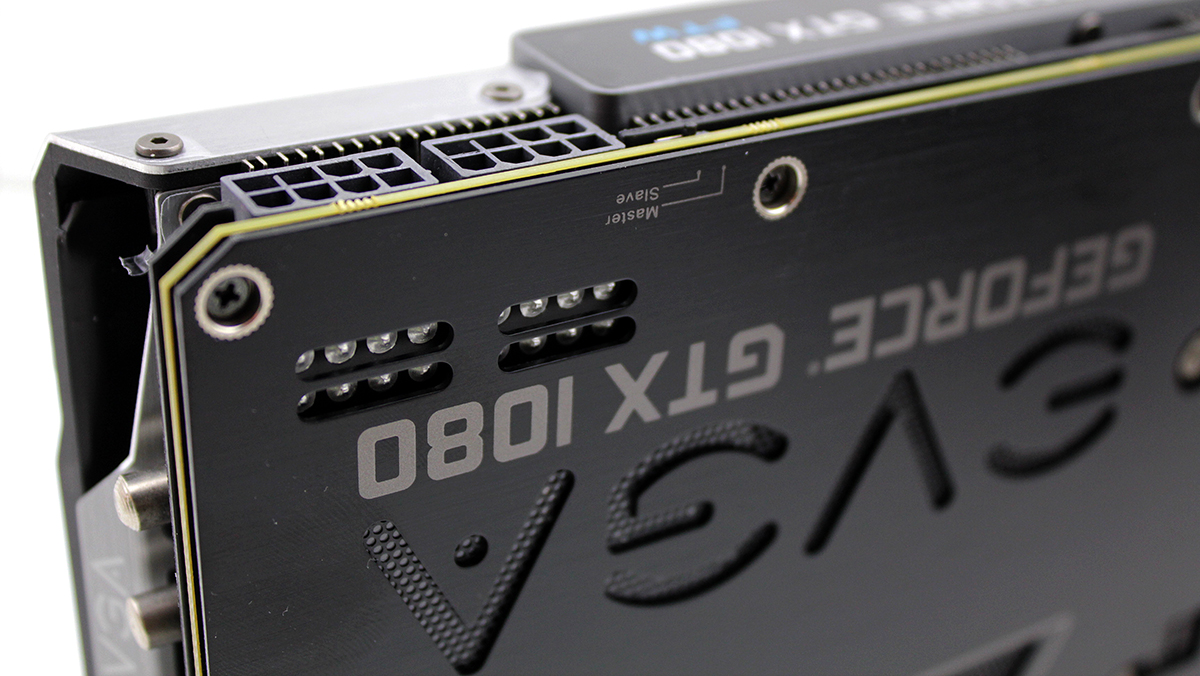
EVGA took an open shroud approach, where fans are positioned on top and blow directly at the heatsink. This approach means that hot air will not be vented from the chassis. Satisfactory airflow ensures the best possible cooling, but it’s nothing that a few quality intake and outtake fans won’t effectively nullify.
The whole cooler is hold only by four screws in vicinity of the GPU but there are no vibrations or signs of instability.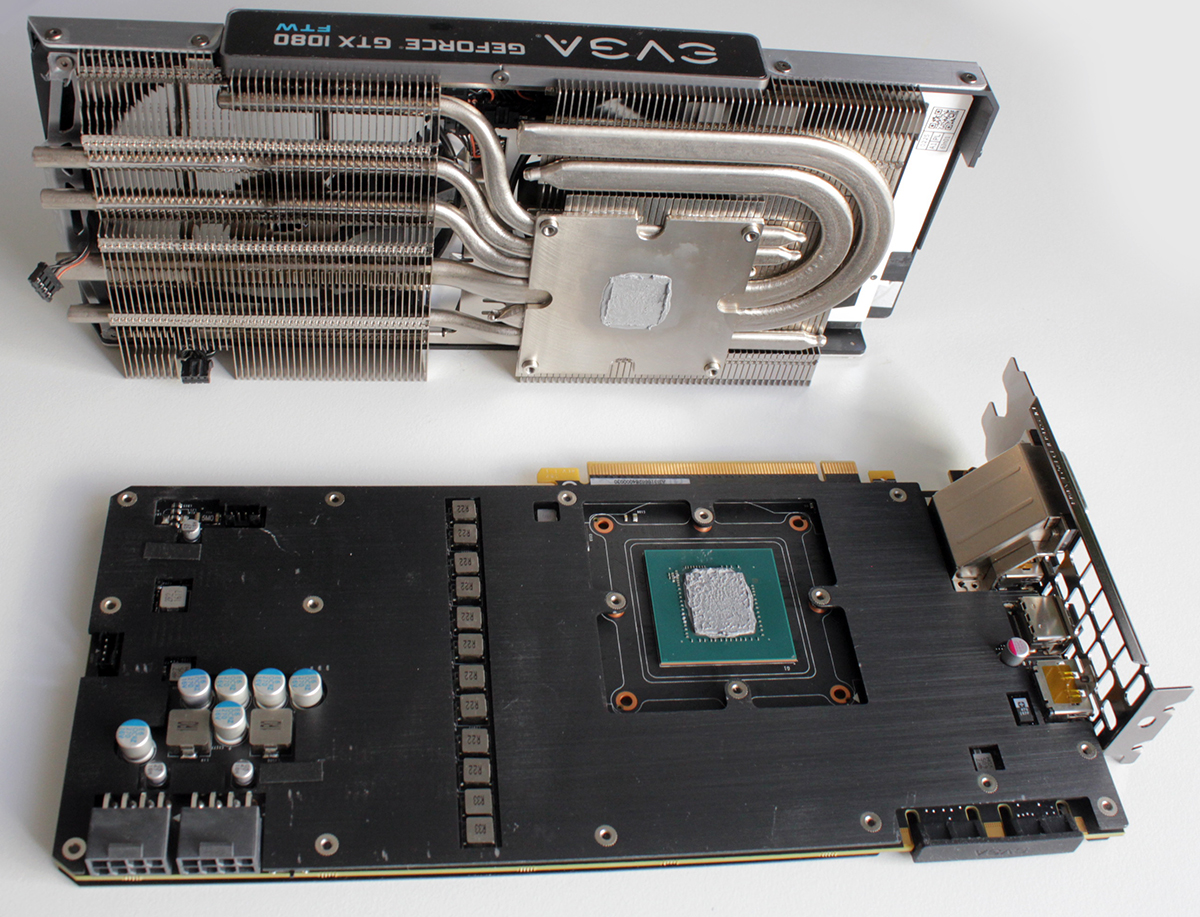
EVGA designed Straight Heat Pipes 3.0 (but as you can see from the image below it is not all that straight) and increased copper contact are to reduce the GPU temperature by 10 per cent, compared to Straight Heat Pipes 2.0 used on the ACX 2.0 cooler. A big copper base covers the small GP104 GPU.
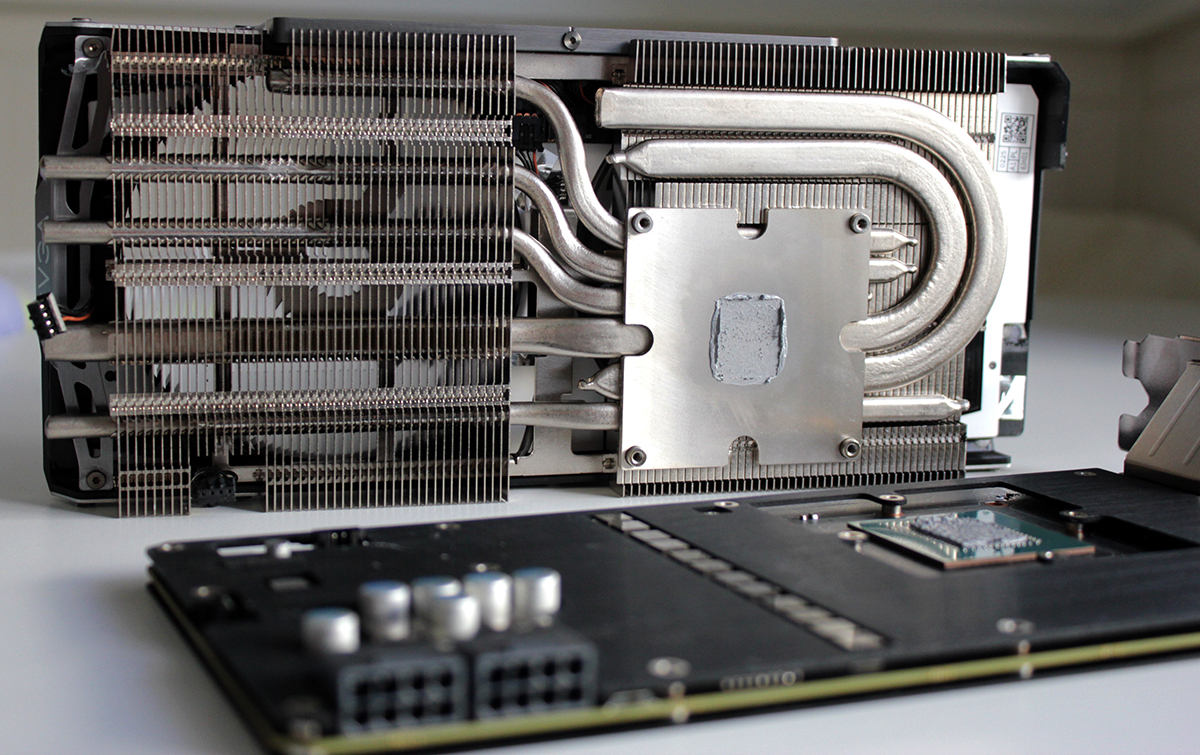
We always advise users to clean the heatsink regularly. It’s good for the card and it also helps keep fan RPMs as low as possible, but cleaning the heatsink can become cumbersome on some cards, as it is a case with the GTX 1080 FTW ACX 3.0. EVGA designed a special heatsink with lots of dissipation surfaces, but you cannot remove the shroud from the heatsink easily. However it is not hard to remove the fans, and clean the heatsink below the fans at least annually.
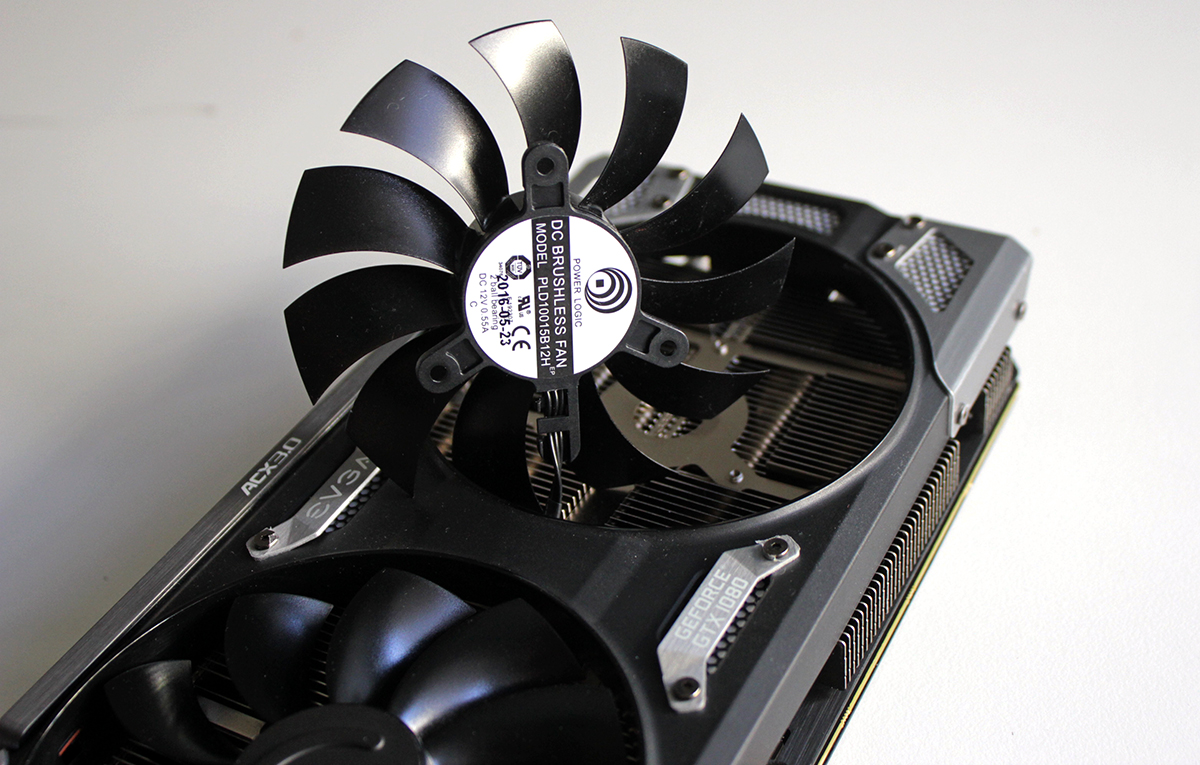
The Power Logic PLD10015B12H fan has some good features. First of all it was chosen due to its dense, curved blade design and double ball bearing design. A poor blade design generates more noise but, this particular 11-blade fan seems to be up to the job. The noise generated by ball bearing designs tends to be low, at least while they are new. Since this fan uses two ball bearings it should last a bit longer and generate a less noise even after a couple of years of wear.
The reference Geforce GTX 1080 comes with three DisplayPorts (DisplayPort 1.4), single HDMI (HDMI 2.0b) and single DVI display outputs. The EVGA FTW card has the same configuration of video outputs. Four video outs can be used at the same time. Since DVI connector lacks analog wiring there is no support for D-sub monitors through dongles. After we become acquainted with Adaptive V-Sync which was introduced with Kepler, and with G-SYNC introduced with Maxwell, now is the time to learn about Fast Sync. This display sync option combines good and bad sides of the two V-Sync modes. Fast Sync provides low-latency but at the same time it eliminates frame-tearing.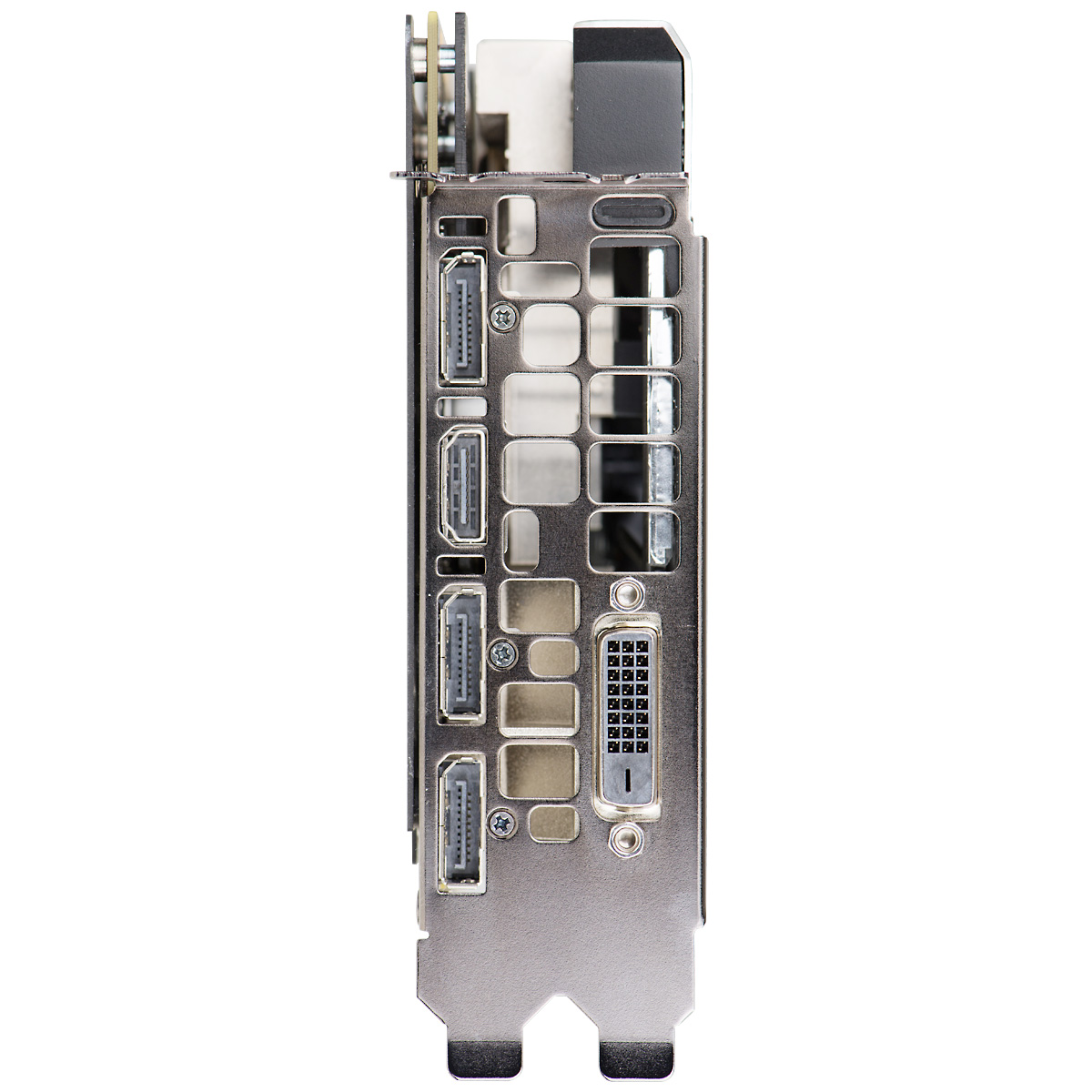
The GTX 1080 FTW is ready for multi-GPU action, but officially supports ony standard two-card SLI setup. This is so that it can provide more bandwith at 4K at 60 Hz and above. To support this, Nvidia developed an advanced high-bandwidth SLI bridges called "SLI HB" which needs both SLI connectors in 2-way SLI mode. Both 3-way and 4-way SLI are still possible using a special software key from NVIDIA (while support in future games depends on the game/benchmark developers). 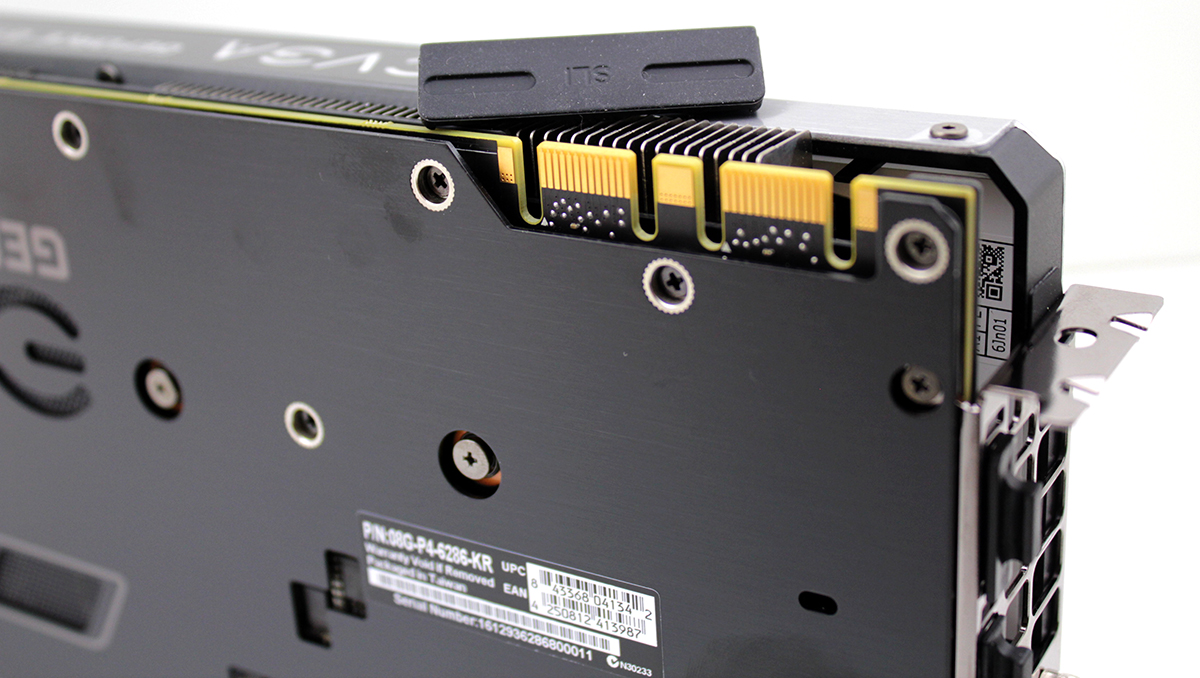
Testbed
Testbed:
- Motherboard: EVGA X99 FTW
- CPU: Intel Core i7 5960K, 4.2GHz (Haswell-E)
- CPU Cooler: Thermalright HR-02
- Memory: 4x4GB Kingston HyperX Predator DDR4 Memory Review (HX430C15PBK4/16)
- SSD:To shiba THNSNJ256GCSU 256GB
- Case: CoolerMaster Cosmos II
- Operating System: Win10 64-bit
Drivers:
- Nvidia 368.81

3DMark
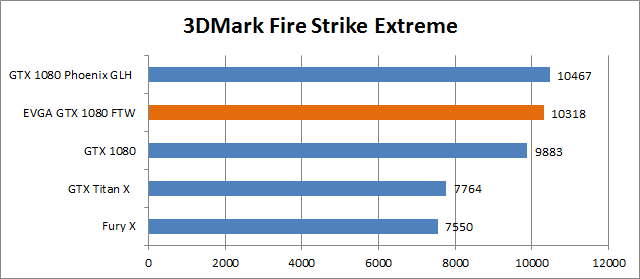
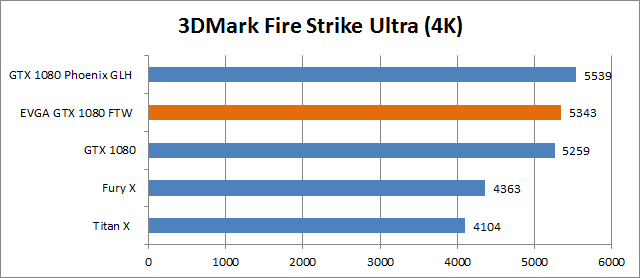
Battlefield 4
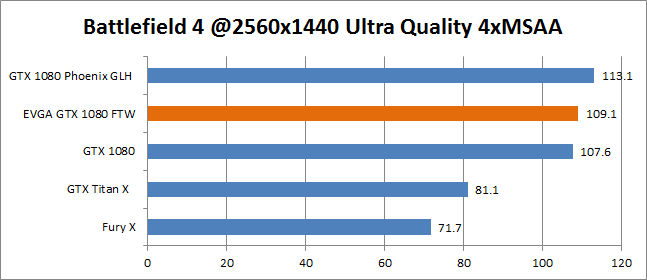
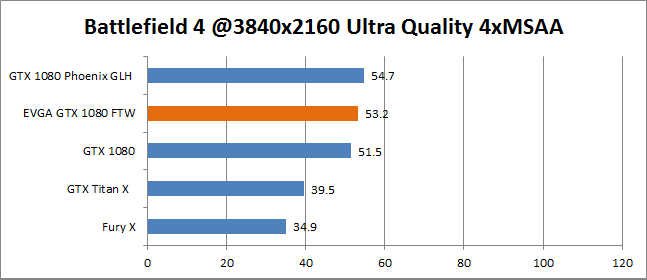
Crysis 3
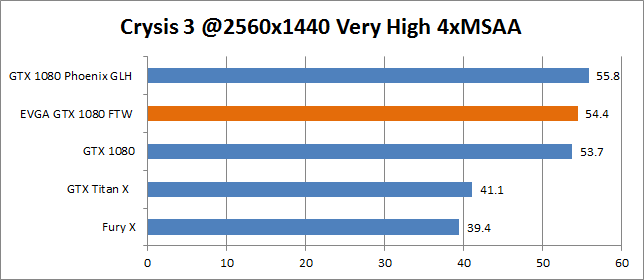
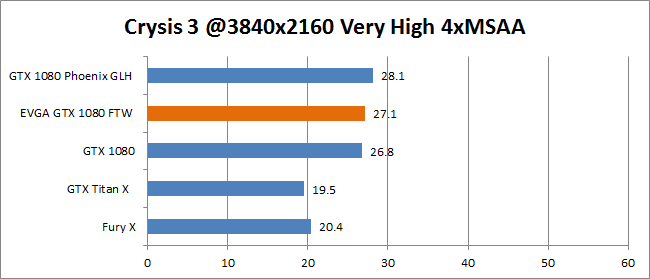
Witcher 3
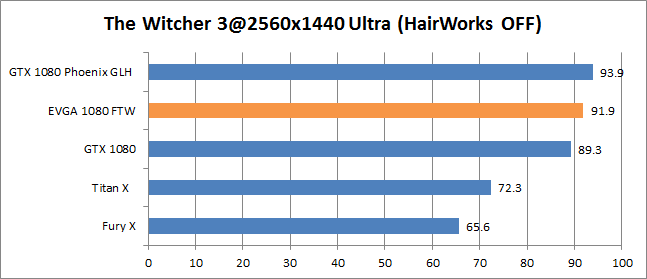
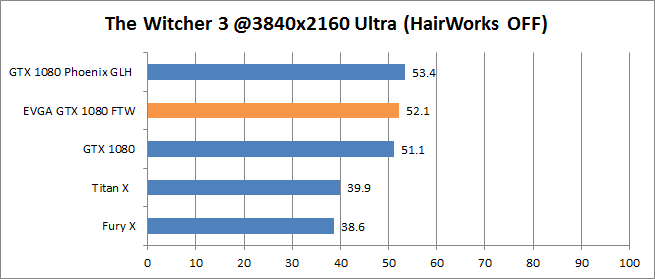
Thermals and Noise
The reference cooler design has not changed much compared to the previous generation. The GTX 1080 has high GPU clocks and the reference cooler is not the best thing to use. It is not really loud or annoying, but it is not quiet either. We are pleased to inform you that the ACX 3.0 cools scores well here.
The new ACX 3.0 cooler is superior to the reference design as it keeps the GPU temperatures below 78 degrees Celsius. The ACX 3.0 cooler ensures the card maintains the maximum Boost clock possible for as long as possible. The new Boost 3.0 algorithm will reduce the GPU Boost clocks on the GTX 1080 if the GPU temperature goes over 83 degrees Celsius, but the ACX 3.0 cooler keeps the GPU temperature significantly lover.
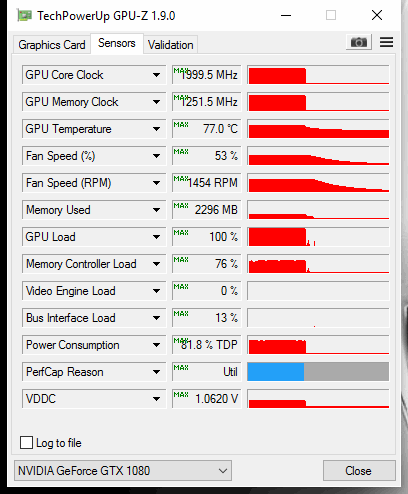
The card is completely silent in idle and during media playback. The card turns its fans off when GPU temperature is below 60 degrees Celsius. The GTX 1080 FTW ACX 3.0 is quiet, almost inaudible, even under load. Below is shown idle temperature measured just after several minutes after we ended a game.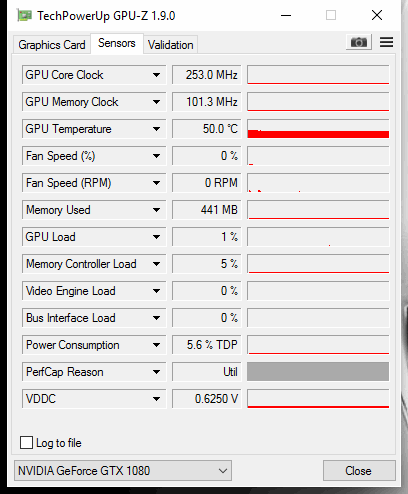
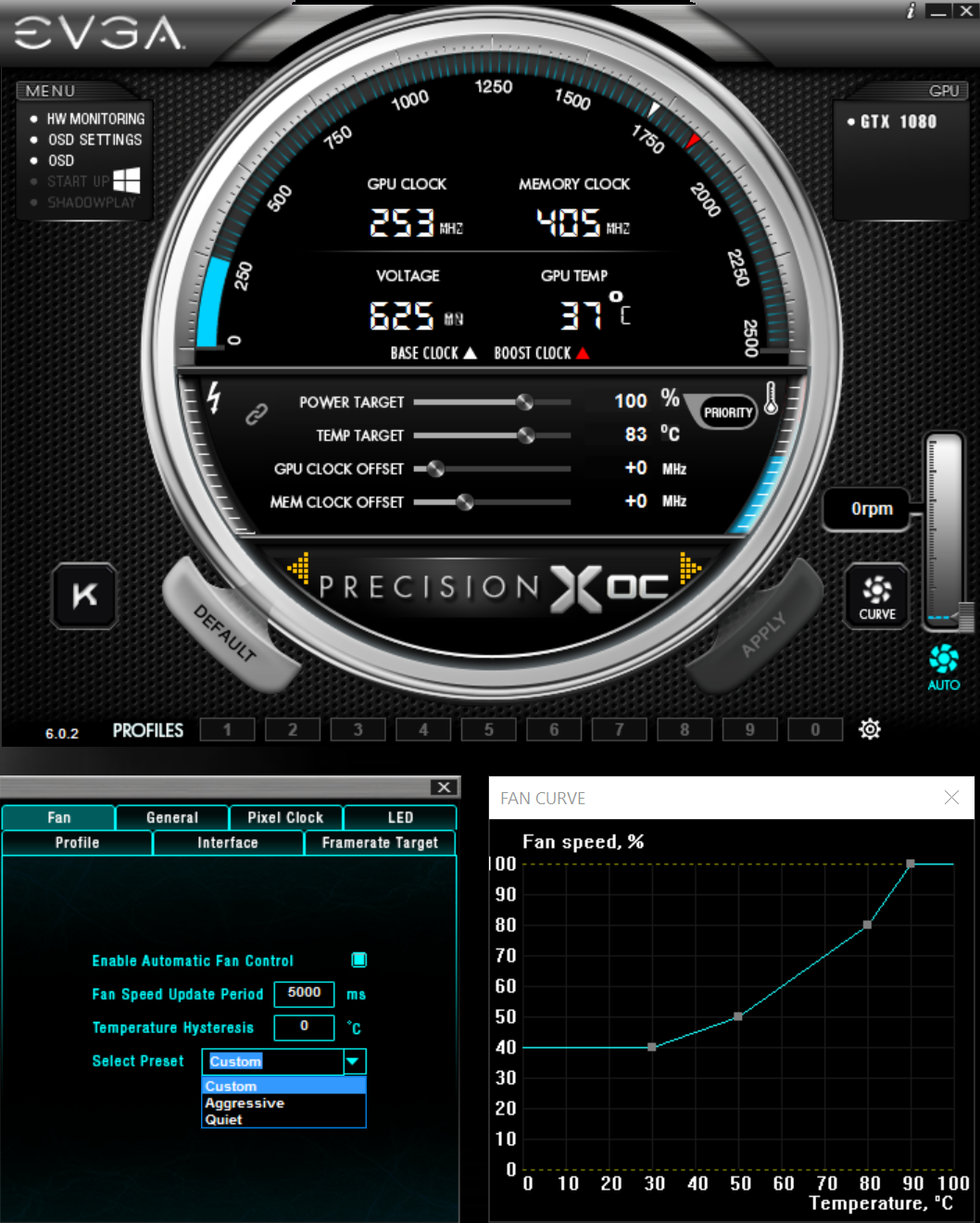
Overclocking
The EVGA GTX 1080 FTW works at a 1721MHz base clock, while the reference GPU base clock is set at 1607MHz. The overclocking potential is good considering that this is a factory overclocked card. Using standard voltage and AUTO fan settings we managed to push the GPU 120MHz over the factory clocks. This resulted in a additional 4-6 per cent performance gain in our games. Note we have increased memory clock. The card remained silent even after our additional overclocking.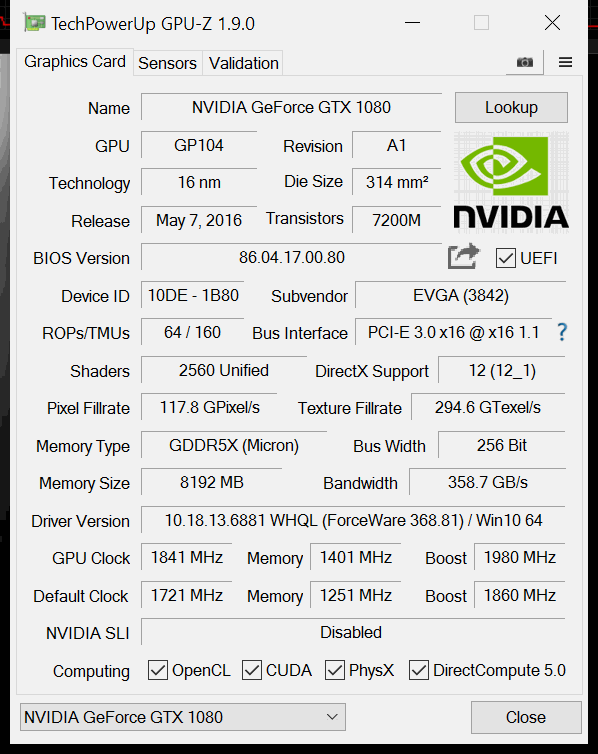
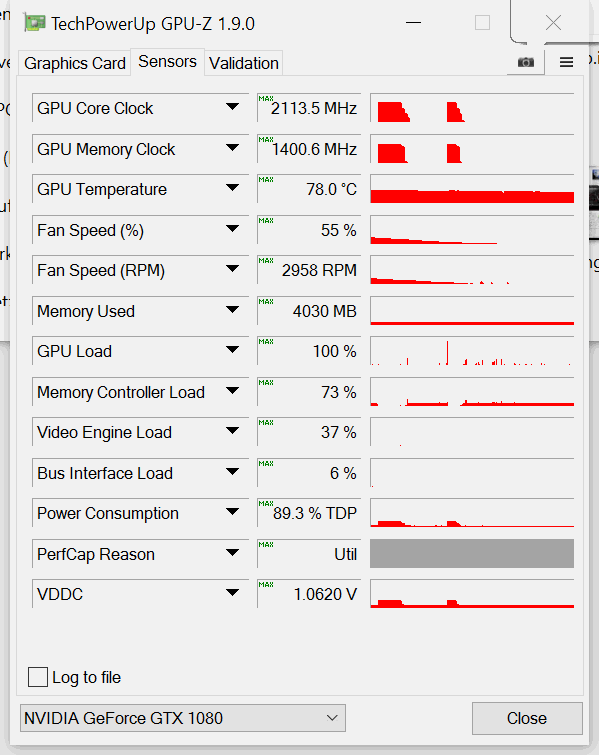
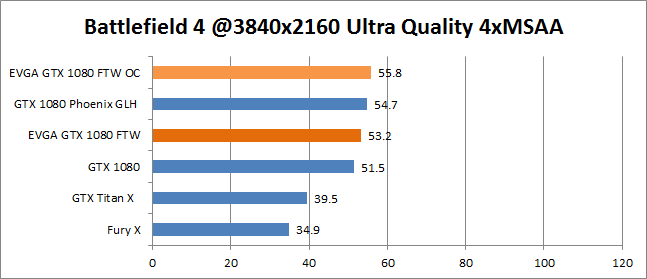
Conclusion
The EVGA GTX 1080 FTW ACX 3.0 graphics card is not the fastest factory overclocked GTX 1080 graphics card, but if we look at the overall package, including cooler design and overclocking performance, this may be the best. Lower performance compared to other factory overclocked GTX 1080 graphics cards comes from the fact that EVGA did not overclock the memory, like Gainward. But the card’s base clock is nearly as high as the GTX 1080 Founders Edition boost clock, so you will see extra performance right out of the box. The new ACX 3.0 cooler looks great and performs great; literally it is quiet in all working scenarios.
Until recently the GTX Titan X was a dream card for the gamers, but it cannot cope in terms of gaming performance and power efficiency with the new king, the GTX 1080.
The EVGA GTX 1080 FTW is fast graphics card, and our conclusion is short. Go for it if you can afford it, with this horse you can win any race.


